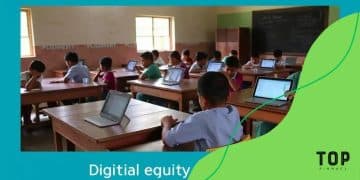Open educational resource (OER) funding explained
Open educational resource (OER) funding is crucial for increasing access to high-quality educational materials and fostering innovation in teaching practices through collaboration and partnerships.
Open educational resource (OER) funding plays a pivotal role in democratizing education today. Ever wondered how this funding can help institutions create free learning materials? Let’s dive into it.
Understanding open educational resources (OER)
Understanding open educational resources (OER) is crucial for enhancing access to quality education. These resources include materials like textbooks, videos, and courses that are freely accessible to anyone. Thanks to technology, teachers and students can easily tap into a wealth of knowledge without financial barriers.
What Are Open Educational Resources?
OER are teaching, learning, and research materials that are either in the public domain or released under an intellectual property license that permits their free use and repurposing by others. This makes them unique compared to traditional educational materials. You might wonder how these resources can impact learning.
Benefits of Using OER
- Cost-effective: Students save money on expensive textbooks.
- Customizable: Educators can adapt resources to better fit their teaching style.
- Accessible: Anyone can use these materials, promoting inclusivity.
The power of OER lies in their versatility. They can be modified to suit various subjects and learning environments. For instance, a math teacher can adjust an OER textbook to focus on specific concepts students struggle with. This adaptability not only improves learning outcomes but also encourages creativity among educators.
Examples of OER
Some common examples of open educational resources include:
- Textbooks available through platforms like OpenStax.
- Video lectures from universities that provide free courses.
- Assessment tools designed for various subjects.
As you explore, keep in mind how these resources can help bridge gaps in education. With their rise, learning is more open than ever, allowing for collaboration and innovation.
Sources of funding for OER initiatives
Identifying sources of funding for OER initiatives is essential for creating and sustaining open educational resources. Many organizations and governmental bodies provide funding to support the development of these educational materials. Understanding where to find this support can make a significant difference in the success of OER projects.
Types of Funding Sources
Funding can come from various places, each offering unique opportunities. Some common sources include:
- Government grants aimed at educational innovation.
- Non-profit organizations that focus on educational equity.
- Institutions of higher education seeking to enhance their programs.
These funds can be used for various purposes, such as creating new resources, adapting existing materials, or conducting research on effective practices for OER adoption. For example, a university might apply for a federal grant to develop a set of interactive textbooks for STEM courses. This approach not only benefits the students but also enhances the university’s reputation as an innovator in education.
Private Sector Contributions
Another avenue for funding is the private sector. Many businesses recognize the value of OER as a tool for increasing literacy and learning opportunities. Companies may offer:
- Sponsorship for specific projects.
- Partnerships to help scale resources more broadly.
- Funding for research on OER usage and effectiveness.
These collaborations can lead to significant improvements in resource accessibility and quality. As private sector partners engage more, they often bring additional expertise and technological advancements that further enhance OER initiatives.
Community and Crowd-sourcing
Additionally, community-based funding and crowd-sourcing have become effective methods for raising support. Platforms that focus on educational projects allow individuals to contribute financially to initiatives they believe in. Some popular options include:
- Kickstarter campaigns for specific OER projects.
- Community grants that support local educational organizations.
- Peer-to-peer funding models where educators share costs.
As more communities recognize the power of OER, the potential for funding through these channels continues to grow. By leveraging various sources, educators and institutions can secure the necessary funds to create high-quality open resources.
Benefits of OER funding for education

The benefits of OER funding for education are numerous and impactful. By providing financial support for open educational resources, this funding helps make education more accessible to all. Students, teachers, and institutions can take advantage of these resources to enhance learning experiences.
Increased Access to Learning Materials
One of the main advantages is increased access to high-quality learning materials. OER funding allows for the creation and distribution of educational resources that are freely available online. This means that anyone with internet access can use these materials without worrying about cost. For students from low-income backgrounds, this can be a game-changer.
Support for Innovative Teaching Practices
OER funding encourages educators to explore innovative teaching methods. With access to a variety of resources, teachers can tailor their lessons to better meet the needs of their students. They can integrate multimedia, interactive elements, and real-world examples into their curriculum, which enhances student engagement and understanding.
- Customizable resources that fit specific classroom needs.
- Encouragement for collaborative projects among educators.
- Opportunities for experimentation with new teaching techniques.
This flexibility can significantly improve educational outcomes, as students are more likely to succeed when learning materials resonate with their interests and learning styles.
Collaboration and Resource Sharing
Another benefit is that OER funding fosters collaboration among educators. Teachers can share resources, ideas, and best practices, leading to a stronger network of educational professionals. With OER, the knowledge gained is not confined to one classroom; it can be shared across districts and even states.
- Building a community of practice around OER usage.
- Sharing adaptations and improvements to existing resources.
- Creating a culture of continuous improvement in teaching and learning.
By working together, educators can create a rich tapestry of resources that benefits everyone involved. This communal approach not only enhances learning but also builds a supportive environment for educators.
Challenges in securing OER funding
Securing funding for OER initiatives can be challenging. While there are many potential sources of support, navigating the landscape can be complex. Understanding these challenges is the first step towards overcoming them and ensuring the sustainability of open educational resources.
Limited Awareness and Understanding
Many educators and institutions are not fully aware of what OER funding entails. This lack of awareness can lead to missed opportunities for financial support. Educators may not know how to apply for grants or where to find relevant funding sources. To address this issue, institutions must provide training and resources to help educators navigate the funding landscape.
Competition for Resources
Another significant challenge is the competition for limited funding. Many organizations offer grants for educational initiatives, but the number of applicants often exceeds the available funds. This can make it difficult for individual projects to stand out. To enhance their chances of receiving funding, applicants should ensure their proposals clearly demonstrate the impact and benefits of their OER projects.
- Highlighting unique aspects of the project.
- Demonstrating a clear plan for implementation.
- Providing sound evidence of community need.
Effective strategies and a strong proposal can help mitigate these competitive pressures.
Changing Funding Landscapes
The funding landscape for educational resources is constantly evolving. Changes in governmental priorities, budget allocations, and educational policies can impact the availability of OER funding. Keeping up-to-date with these changes can be a daunting task for educators and administrators. Engaging with professional networks and regularly reviewing funding opportunities can help adapt to these shifts.
- Joining online forums and groups focused on OER.
- Subscribing to newsletters from funding organizations.
- Attending conferences and workshops on educational funding.
By staying informed, stakeholders can better position themselves to take advantage of new funding opportunities as they arise.
Future of OER funding and access
The future of OER funding and access appears promising as education continues to evolve. With increasing recognition of the importance of open educational resources, more stakeholders are advocating for funding initiatives. This growing interest can lead to greater accessibility for learners worldwide.
Emerging Funding Models
As we look forward, new funding models are being developed to support OER initiatives. Collaborative funding approaches are gaining traction, where multiple organizations come together to pool resources. This can significantly enhance the financial support available for OER projects.
Public-Private Partnerships
Public-private partnerships are playing a crucial role in the future of OER funding. By collaborating with businesses, educational institutions can access additional resources that can help create richer, more diverse materials. These partnerships can also drive innovation in educational practices.
- Encouraging businesses to invest in educational projects.
- Utilizing corporate social responsibility funds for OER creation.
- Facilitating mentorship opportunities through industry involvement.
Such cooperation can lead to resources that are not only current but also engaging for students.
Increased Advocacy for Open Education
Advocacy for open education is likely to grow, leading to more funding for OER initiatives. Educators and institutions are becoming champions of open access, pushing for policies that support OER development and use. As more institutions adopt open education policies, funding opportunities will likely expand.
Organizations and governments worldwide are starting to recognize the need for equitable access to education. This shift can increase the number of grants available, enabling institutions to develop high-quality educational resources tailored to their communities.
Technological Advances Enhancing Access
Technology continues to advance, providing new tools for creating and sharing OER. As platforms for OER resources become more sophisticated, access will broaden. Mobile technology, in particular, has the potential to reach learners in remote areas where traditional educational materials are scarce. This evolution of technology will provide a platform for educators and learners to connect and share resources in innovative ways.
- Developing mobile-friendly resources that can be accessed on various devices.
- Integrating AI tools to personalize learning experiences.
- Utilizing data to assess the effectiveness of OER materials.
With these developments, the future looks bright for OER funding and accessibility, creating new pathways for teaching and learning.
FAQ – Frequently Asked Questions about OER Funding and Access
What are open educational resources (OER)?
Open educational resources (OER) are teaching, learning, and research materials that are freely accessible and can be modified to suit different educational needs.
How can OER funding improve education?
OER funding can enhance education by providing free access to high-quality learning materials, allowing educators to innovate and tailor resources to their students’ needs.
What types of organizations provide funding for OER?
Funding for OER can come from various sources, including government grants, non-profit organizations, educational institutions, and private sector contributions.
What challenges exist in securing OER funding?
Challenges include limited awareness about OER funding opportunities, competition for resources, and the changing landscape of funding policies that can affect availability.






